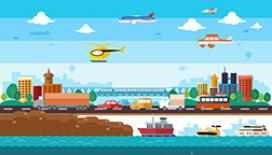Planning Across Borders: Transportation Strategies for Megaregions
Transportation planning—and funding—typically happens within political boundaries, even though travelers and goods often cross those borders in their regular movements. Innovations that decrease congestion, reduce environmental impacts, or make roads safer may be implemented in one city, but not in a neighboring one.
But with the rise of megaregions—collections of large cities, suburbs, exurbs, and the areas between, characterized by concentrated economic opportunities and huge transportation challenges—some planners are changing how they approach their work. They’re expanding their thinking—across local, metropolitan area, state, and even international borders.
As planning becomes more collaborative and less impacted by boundaries, innovations can be implemented across megaregions, which may lead to more seamless transportation.
Taking Stock of the Megaregion Planning Landscape
A report by the Federal Highway Administration (FHWA) and Volpe highlights noteworthy practices from metropolitan planning organizations (MPOs) working with partners to plan with emerging megaregions in mind.
Megaregions encompass economic, environmental, and cultural boundaries that may not mesh with traditional borders, such as state lines or the Census-defined MPO borders. Atlanta is the hub of the Piedmont-Atlantic megaregion, which covers six states and extends to the ports of the Southeast. The Cascadia megaregion flows from British Columbia to Oregon and Washington, while the Northeast megaregion includes states from Maine to Pennsylvania.

“This report is a valuable resource for planners to understand the state of thinking around megaregion planning,” said Haley Peckett, a planner at Volpe and one of the report authors. “Many departments of transportation and MPOs look to FHWA for how to achieve best practices. The emphasis around megaregions has been an area that FHWA has been interested in for years.”
The challenge with megaregion planning is that agency staff must work within the current system, which was not created with fluid geopolitical borders in mind. But within this framework there is room for creativity in megaregion planning, and MPOs play a range of roles and work with different levels of government and the private sector.
Highlights of Successful Planning for Megaregions
Sustainability is a major theme for megaregion planning in the Front Range region, where rapid development and population growth are straining regional natural resources and scenic areas. The planning process in the Front Range region does not include formal agreements, but relies on strong relationships and frequent communication to coordinate transportation projects that meet the needs of the public but do not severely impact the natural environment.
In Central Florida, myregion.org is a partnership of seven counties and 86 regions in the Orlando metropolitan area that includes a diverse range of representatives, such as elected officials, universities, economic development organizations, business leaders, energy providers, environmental interests, operators of all modes of transportation, and private citizens.
This partnership is an award-winning effort focused on cross-jurisdiction planning work. While not a full megaregion initiative, myregion.org offers an instructive model focused on visioning efforts. These efforts have shaped goals, strategies, resolves, and implementation actions that consider broad regional needs and connections between diverse sectors.
Other areas around the country interested in encouraging megaregion planning might consider creating a vision as an early step to initiate and guide planning activities. The regional visioning model has been effective in applying creativity within the federal planning framework.
The I-95 Corridor Coalition is the largest and most established megaregion alliance in the country. Coalition members—including state DOTs, transportation and port authorities, Amtrak, federal transportation agencies, Canadian transportation agencies, MPOs, and the private sector—are playing increasingly important roles in shaping transportation decisions along the corridor. This coalition serves as a launching pad for new mobility initiatives, including projects that allow this economically critical region to thrive.
“One way of looking at the challenges of planning for megaregions is that the whole is greater than the sum of the parts,” said William Lyons, a principal technical advisor for planning at Volpe and a report coauthor. “By working together, MPOs and other agencies can strengthen transportation in the larger megaregion to the benefit of the individual regions sharing resources and cooperating on projects. Cooperation lets regions stay competitive in ways they would not be able to do individually.”
This report is part of a series from FHWA and Volpe that assesses the landscape of transportation planning across the country. Volpe news covered the previous report on multimodal planning and urban economic development in February.

